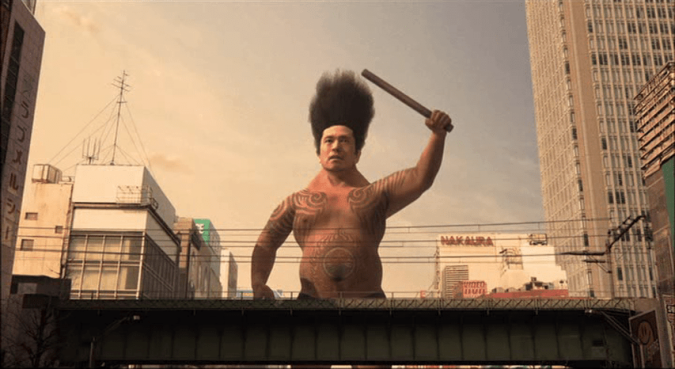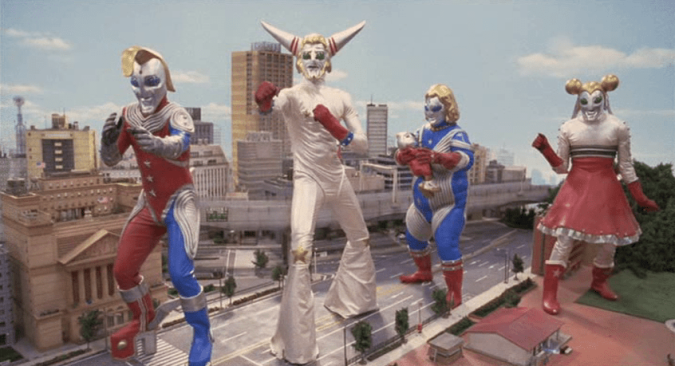 A documentary crew is filming a rather drab man called Daisato as he goes about his daily activities. He never goes anywhere without his folding umbrella and lives alone in a dumpy little home, He is the essence of the temp worker, for he must constantly be on call with only a tiny retainer. When he gets the call to work, he goes to a power plant where he is fed with electricity until he becomes the superhero Big Man Japan, who must protect Tokyo from any new monsters.
A documentary crew is filming a rather drab man called Daisato as he goes about his daily activities. He never goes anywhere without his folding umbrella and lives alone in a dumpy little home, He is the essence of the temp worker, for he must constantly be on call with only a tiny retainer. When he gets the call to work, he goes to a power plant where he is fed with electricity until he becomes the superhero Big Man Japan, who must protect Tokyo from any new monsters.
This launches us into Hitoshi Matsumoto’s deadpan story of the woes of a real-life superhero, Big Man Japan. Matsumoto at the time was one of Japan’s most popular comedians, the goofy one in a manzai team called Downtown. Like another manzai comedian Takeshi Kitano who came to film without his partner, he writes and directs the film, and also like Kitano inverts his usual persona, not into a gangster but into a quiet, withdrawn, and rather pathetic man caught in a job he doesn’t like and is actually not very good at. He does it because it is the family trade. He is the sixth Big Man Japan, pushed into the job after his father (#5) electrocuted himself in his attempt to grow even bigger and his grandfather (#4) started to become senile and had to go into a retirement home. He wants to pass along his position to his child, but she is a girl, and his wife has left him to make sure her daughter never has to go through the pain of the conversion and can grow up normally.
Grandfather (#4) was a big star, arising in the age of Gojiro when there were new monsters to be seen everywhere and even competitors for the role of monster-killer.  But now the monsters just aren’t what they used to be when his grandfather was a big star, living large (sorry but I couldn’t resist), surrounded by geisha and given patriotic parades, always in the newspapers, newsreels, or on TV. Daisoto’s adventures still appear on TV, but usually in the middle of the night, after the home shopping hour. Daisoto is now a figure of ridicule, and even of outright complaint and public opposition. His house is surrounded by a fence covered in negative graffiti, and as he talks to the interviewer, the occasional rock comes through a window, which he doesn’t even notice anymore. He can only afford a motor scooter, though his agent somehow has a flashy new car and two matched Afghan hounds with her. When he rides the scooter to the electric plant, the road is lined with signs telling him to go home because his conversion makes too much noise, the electricity drives away the birds, etc. Yet still he plods on because it is his duty.
But now the monsters just aren’t what they used to be when his grandfather was a big star, living large (sorry but I couldn’t resist), surrounded by geisha and given patriotic parades, always in the newspapers, newsreels, or on TV. Daisoto’s adventures still appear on TV, but usually in the middle of the night, after the home shopping hour. Daisoto is now a figure of ridicule, and even of outright complaint and public opposition. His house is surrounded by a fence covered in negative graffiti, and as he talks to the interviewer, the occasional rock comes through a window, which he doesn’t even notice anymore. He can only afford a motor scooter, though his agent somehow has a flashy new car and two matched Afghan hounds with her. When he rides the scooter to the electric plant, the road is lined with signs telling him to go home because his conversion makes too much noise, the electricity drives away the birds, etc. Yet still he plods on because it is his duty.
The monsters are second-rate too. No Godzillas or Mothras challenge him. Rather they seem like modern versions of the yokai monsters of old, built around odd physical traits and everyday objects.
He faces an elastic thing with a bad comb-over who likes to pick up a building and turn it upside down. Then there is the monster with a single leg who just likes to bounce on buildings or ride the Osaka wheel, or a monster with a big eye at the end of a penis-like tube that it can shoot out to hit things, but must roll it back inside its body before it can be used again. Then there are the Stink Monsters, each come to the Big City to find a mate. One is even a baby which only wants to go to the suburbs and find its mother, but Big Man drops it when it bites his nipple while trying to suckle. After that, no one wants to sponsor him or his TV specials. But the worst is a red creature with a giant head, from whom Big Man eventually runs away. This gives him the best ratings he has ever had but makes him even more of a joke to society at large. His wife refuses to let him see his child, the Big Man franchise goes broke, and to top it off his grandfather manages to escape from the retirement home and go around Tokyo destroying buildings. The final humiliation comes when the red monster returns and Big Man has to be rescued by an Ultraman-like family who take him away to their star world home.  When last seen under the credits, they are all at dinner arguing about what they should have done differently to look better on TV.
When last seen under the credits, they are all at dinner arguing about what they should have done differently to look better on TV.
As these points suggest, there is a lot of satire going on here that requires a more detailed understanding of Japanese TV culture than I have.* Japanese film as well as TV in 2007 was in the grip of their own super-hero franchises – other super-hero movies of the year that did even better at the box-office included Monkey Magic, Kitaro Zero, another installment of Evangelion, of Kamen Rider, and of Gekiranger, and even a super-hero Pokemon, almost all of which also had concurrent TV series. Nevertheless, the dry humor of the movie and the oddity of the monsters still translate well. For the most part it is not a laugh out loud movie, but the Comb-Over Monster is unforgettable. Since I am not conversant with the Ultraman universe, their episode seems to go on longer than necessary, though the use of their baby as a projectile is quite a surprise.
Many of the sight gags need no translation or specific cultural information. He always travels with a collapsible umbrella and likes dried seaweed because it expands. If you’ve ever wondered how the giant superhero always manages to still have his pants on, this will explain it. There are religious rituals that must be gone through before his transformation, but nobody knows why they must be followed and the priest is willing to stop in the middle and start over for the cameras, even though the monster is already at large, much to Daisato’s confusion.
It takes him days to shrink back to normal size, so he hides out at an inn which keeps him in a separate annex. He meets his daughter in a Bob’s Big Boy diner. Grandpa’s escapade is as visually delightful as it is a sign of his senility.
The core of the movie is still Daisato, who has inured himself to the regular humiliation of his job, just like any salaryman. Whatever the interviewer asks him, he always seems a bit lost before he can find an answer, yet he never answers with a joke. Manzai comedy is built on speed, but Matsumoto slows everything down. Whatever the issue at hand, he always loses the argument eventually, whether about the placement of sponsor logos on his body or how his daughter will be shown on camera.  He is a very real “average man” who just wants his wife and daughter and a regular life but is trapped by his forebears and must soldier on. For his final battle, when he has tried to quit, a SWAT team raids the house and hooks him up in his sleep. Thus in a sense it is a satirical look at the pointlessness of most jobs – his just happens to be fighting oversize monsters who will often disappear without his defeating them, just as Gojiro reappears and disappears without any particular reason. He is something of a middle-aged Spiderman who doesn’t really want his “gift,” and who just wants to be normal.
He is a very real “average man” who just wants his wife and daughter and a regular life but is trapped by his forebears and must soldier on. For his final battle, when he has tried to quit, a SWAT team raids the house and hooks him up in his sleep. Thus in a sense it is a satirical look at the pointlessness of most jobs – his just happens to be fighting oversize monsters who will often disappear without his defeating them, just as Gojiro reappears and disappears without any particular reason. He is something of a middle-aged Spiderman who doesn’t really want his “gift,” and who just wants to be normal.
* I think there may even be joke credits: Riki Takeuchi of the magnificent hair-do is credited as the Comb-Over Monster, though what we see is a toy with a round face who never speaks. Sometimes Matsumoto’s name is misspelled, at least in subtitles, though this may be the same transliteration problem discussed in Tsugumi.









Pingback: Sinking of Japan / Nihon chinbotsu (2006) | Japanonfilm